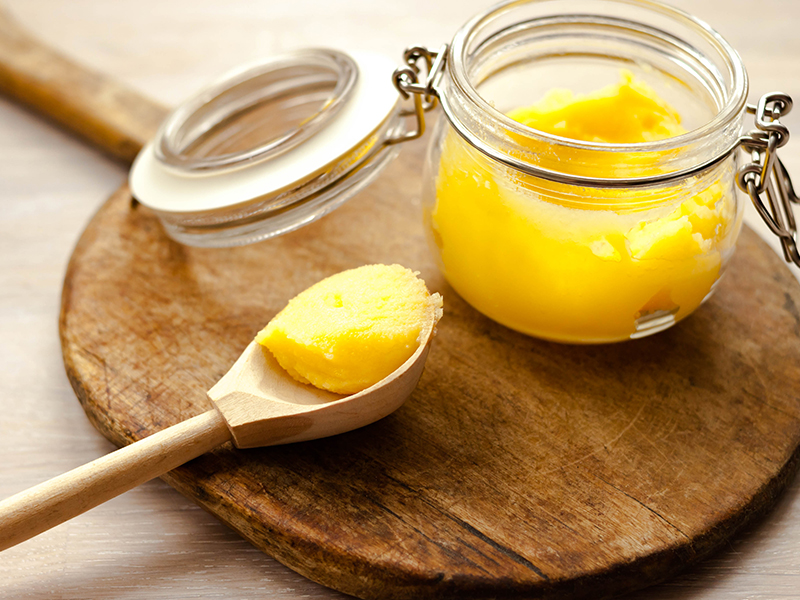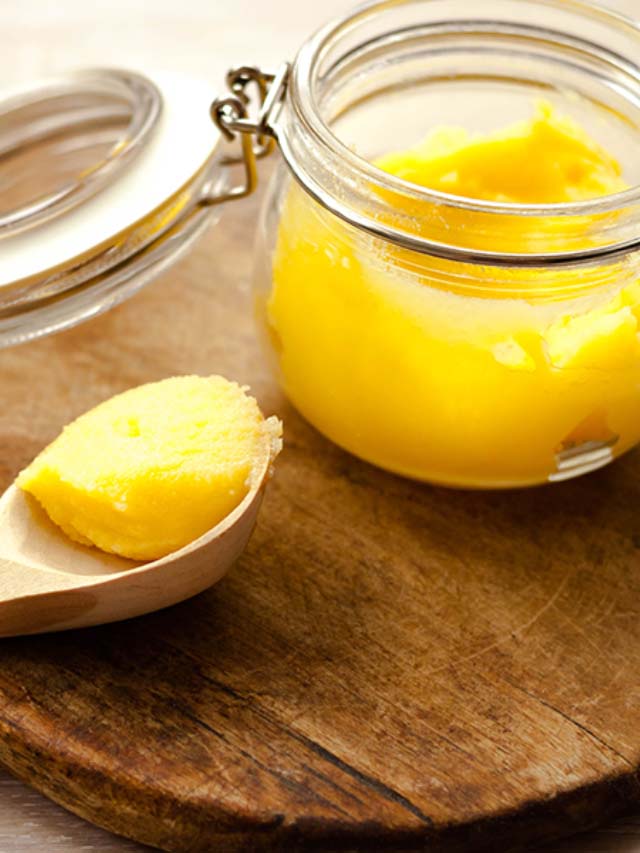Piping hot sambar, fluffy warm rice, topped with ghee! Or garma garam pooris and aamras drizzled with a copious amount of ghee! Nothing can make desi food better like this magical concoction. Butter after clarification and removal of milk solids becomes ghee. Ghee has been a part of the Indian kitchen for ages. Ghee has anti-inflammatory and anti-cancer properties. It is also known to boost the immune system and improve memory. Despite these numerous benefits, ghee has earned a bad reputation, especially among weight watchers. Many individuals assume that ghee contributes to weight gain but are unaware of the fact that ghee when consumed in moderation can contribute to weight loss. Healthy on the inside, beautiful on the outside. Here is how to use ghee for hair to get gorgeous looking hair.
Nutritional Values
| Ghee (15 gms) | Nutritional value |
| Energy | 135 kcals |
| Carbohydrate | 0 gm |
| Protein | 0 gm |
| Fat | 15 gms |
Benefits Of Ghee
Everyday kitchen items for a flawless skin. Here are some ghee benefits for skin to enhance your daily skincare routine. Now that you know the nutritional value of ghee, let us look at some benefits of ghee.
1. Improves Digestion
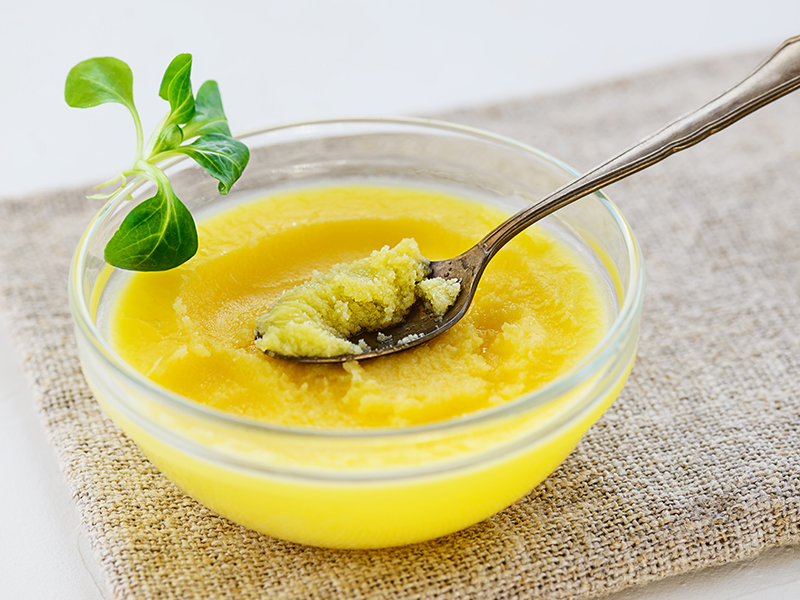
Consumption of ghee can increase gut immunity. Consumption of ghee can also reduce the risk of gut-related cancers or ulcers.
2. Has Anti-Inflammatory Properties
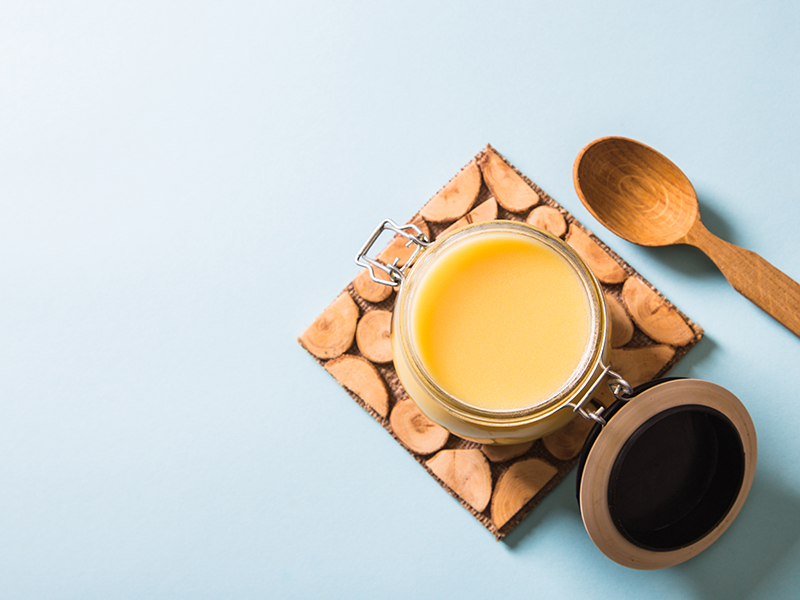
Inflammation is associated with an increased risk of developing cardiovascular diseases and diabetes. Ghee is a good source of antioxidants and omega-3 which is anti-inflammatory in nature. Ghee also contains anti-inflammatory butyrate.
3. Reduces Menstrual Issues
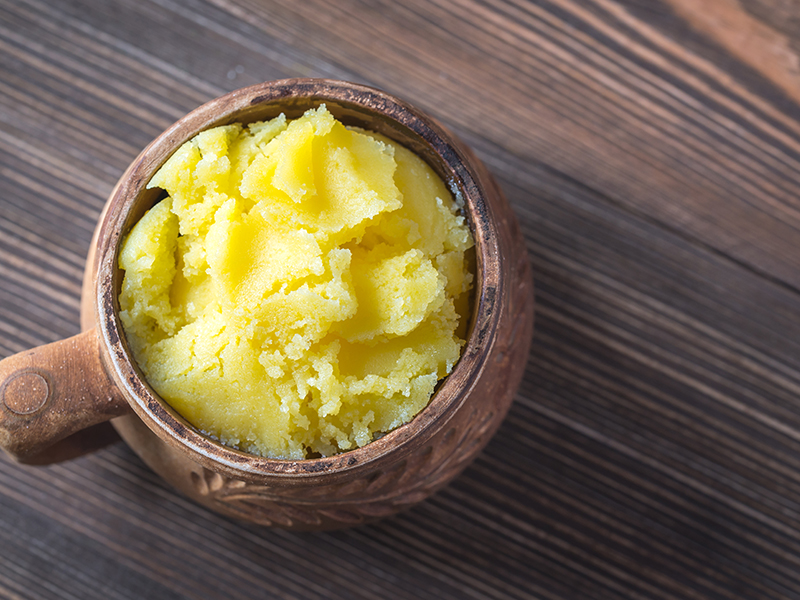
Ghee can be beneficial in reducing the symptoms associated with Premenstrual Syndrome (PMS). Ghee can also reduce the incidence of irregular periods.
4. Claims To Be Anti-Cancer
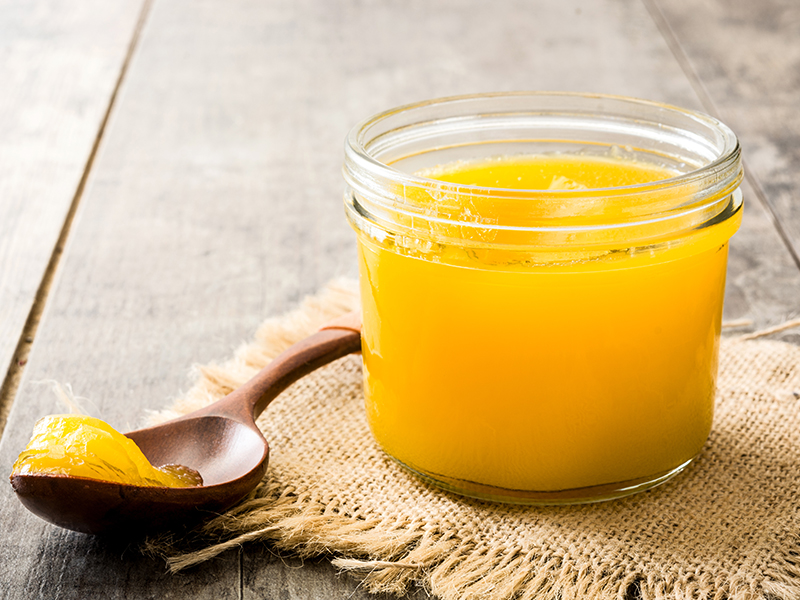
Ghee contains Conjugated Linoleic Acid (CLA) which has anti-cancer properties. Ghee also contains antioxidants that have anti-cancer properties as well.
5. Acts As A Moisturizer

Ghee helps to combat the dryness of hair and skin. Ghee can also promote the growth of luscious and strong hair.
Does Consumption Of Ghee Result In Weight Gain?
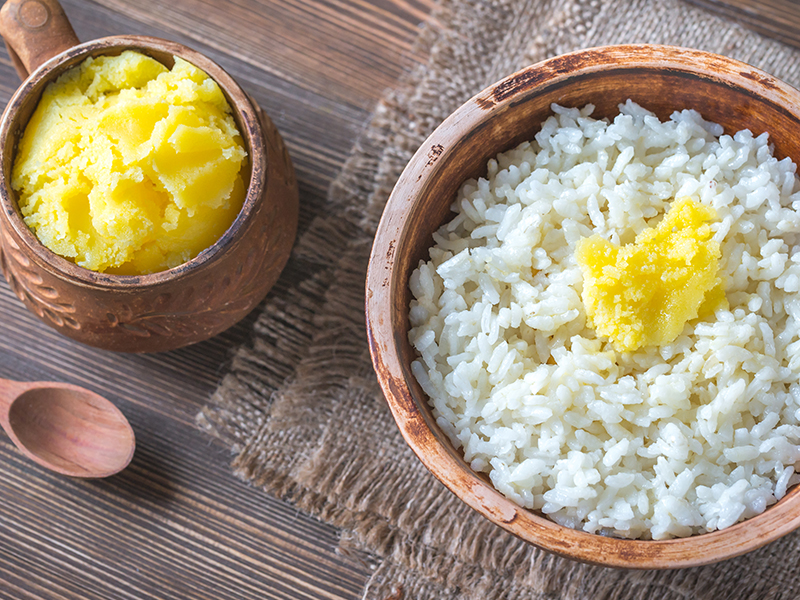
Ghee can boost up your energy metabolism, thus promoting weight loss. Ghee contains Conjugated Linoleic Acid (CLA) that aids in weight management. Ghee also contains monounsaturated fats which help in burning fat as well. Omega-3 fatty acids present in ghee can also lower the levels of triglycerides.
Nutritional Recipes
Now that you know the benefits of ghee, let us look at some delicious recipes that incorporate ghee.
1. Masala Dosa
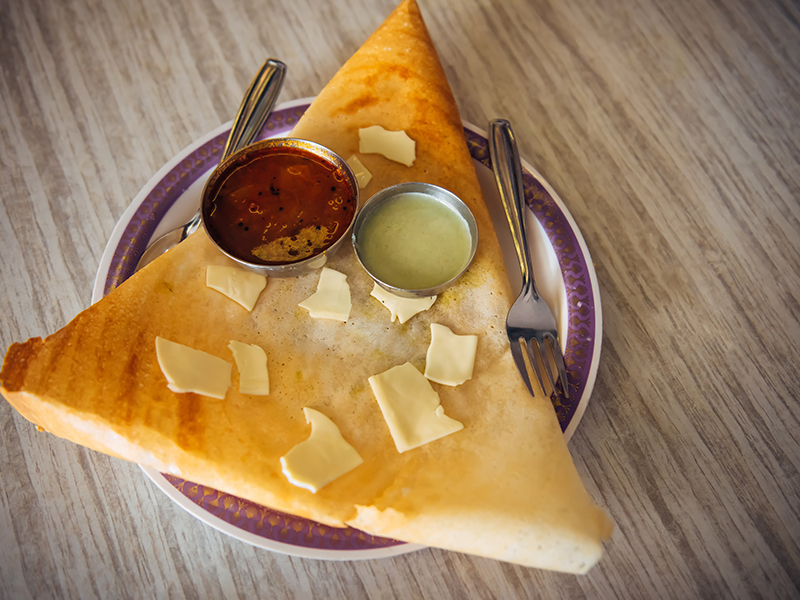
This tasty dish is sure to lighten up your day! The addition of ghee adds to the taste and satiety of the recipe.
Cooking time: 25-30 mins
Nutritional values (1 serving approx)
Energy: 165 kcals
Carbohydrates: 25 gms
Protein: 10 gms
Fat: 15 gms
Ingredients:
- 2 cups rice
- 1 cup urad dal
- Salt to taste
- 2-3 green chillies (chopped finely)
- Ghee for cooking
For stuffing:
- ½ cup peas
- ½ cup cauliflower
- 1 small tomato (chopped finely)
- 2 big potatoes (boiled and mashed)
- 2 big onions (finely chopped)
- Few coriander leaves (for garnishing)
- 1-2 tsp lemon juice
- 2 tsp ginger-garlic paste
- 2 tsp turmeric powder
- 1 tsp chilli powder
- 1 tsp cumin seeds (jeera)
- 2 tsp coriander powder
- 2 tsp garam masala
- A cup of water (for cooking)
- Salt to taste
- Oil for cooking
Method:
- Soak the dal and rice for at least six hours.
- Grind the dal and rice and turn it into a paste. Add around ¾th cup of water if needed.
- Add salt to the mixture and soak it for at least 8 hours.
- In a vessel, pressure cook cauliflower florets along with potato, peas and keep them aside.
- Mash the potatoes, chop the onions and keep them aside.
- In a pan, heat oil. Add cumin seeds and let them crackle. Add the onions and saute them till it turns translucent.
- Add the tomatoes along with salt, chilli powder, coriander powder, garam masala, turmeric powder and ginger-garlic paste. Add the potatoes, chillies and cauliflower as well. Mix well.
- Add lemon juice along with coriander leaves and keep the mixture aside.
- Grease another pan with ghee and pour the dosa batter onto the pan. Add the ghee on the sides of the dosa as well for crispiness. When one side of the dosa gets cooked, flip over the dosa and cook the other side as well.
- Add the vegetable stuffing onto the dosa and gently fold the dosa. Squeeze the dosa gently. Serve hot along with sambar or coconut chutney.
2. Ragi Laddoo
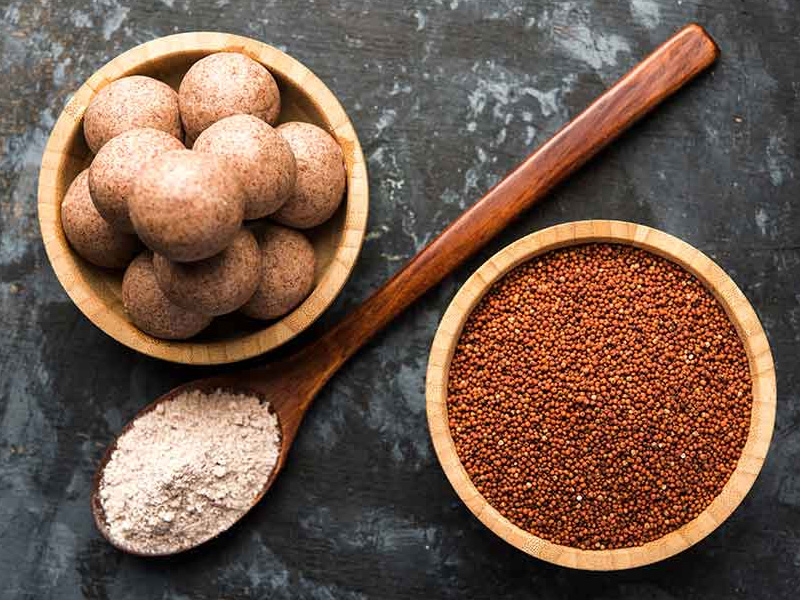
This is an iron-rich recipe and could be beneficial for women suffering from anaemia. The addition of walnuts and ghee adds to the nutrient density as well as the taste of the recipe.
Cooking time: 15-20 mins
Nutritional values (1 serving approx)
Energy: 125 kcals
Carbohydrates: 25 gms
Protein: 2.5 gms
Fat: 10 gms
Ingredients:
- 1 ½ cup ragi flour
- ½ cup walnuts
- ½ cup chana dal
- 1 tsp cardamom powder (elaichi powder)
- Ghee for cooking
- Jaggery to taste
Method:
- Roast the walnuts in ghee. After the walnuts get roasted in the same pan, roast the ragi flour for 10-15 minutes on a low to medium flame. Add more ghee if required.
- Take a blender. Blend the dal and walnuts in the blender.
- Grate jaggery. Add this jaggery to the walnut and dal mixture. Mix well.
- Grease hands with ghee and start making ball-shaped laddoos. Enjoy!
3. Moong Dal Halwa

This tasty halwa is sure to delight your evenings and impress your guests as well!
Cooking time: 40-45 mins
Nutritional values (1 serving approx)
Energy: 255 kcals
Carbohydrates: 25 gms
Protein: 11 gms
Fat: 20 gms
Ingredients:
- 1 cup moong dal
- 1 tsp cardamom powder (elaichi powder)
- Ghee for cooking
- 2 tbsp pistachios
- 1 tbsp almonds
- 1 cup milk
- Sugar to taste
Method:
- Soak the dal overnight. Wash the dal and grind it to a smooth paste in a mixer. Add around ¼ cup water while blending, if required.
- In a pan, heat ghee. Add the moong dal paste to the ghee.
- Keep stirring the moong dal till the smell of the moong goes away. Keep stirring the moong mixture till it becomes granular and yellowish.
- Meanwhile, heat milk in another pan. Add sugar and a cup of water to the milk. Bring the milk to a boil. Add milk to the moong mixture. Mix well. Keep stirring the mixture till the liquid evaporates.
- Once the liquid evaporates, add the chopped nuts to the mixture. Serve hot.
4. Cauliflower Paratha

This tasty paratha can be carried in tiffins and can also be a great addition to your Sundays!
Cooking time: 20-25 mins
Nutritional values (1 serving approx)
Energy: 195 kcals
Carbohydrates: 26 gms
Protein: 5 gms
Fat: 10 gms
Ingredients:
- 1 cup wheat flour
- 1 cup cauliflower (grated)
- 1 tsp cumin seeds (jeera)
- 1 medium onion (finely chopped)
- 2-3 chillies (finely chopped)
- Few coriander leaves (finely chopped)
- Oil for cooking
- Ghee for cooking
- Salt to taste
Method:
- In a bowl, add wheat flour, salt and oil. Turn it into a dough.
- In a pan, heat ghee. Add mustard seeds and let them crackle. Add the onions and chillies and saute for a while on a medium flame.
- Add the cauliflower and saute for a while.
- Add salt and ½ a cup of water. Mix well. Cover the pan and let the mixture cook for a few minutes. Add coriander as well.
- Turn off the flame after the mixture cooks and keep the stuffing aside.
- Roll out the dough and place the stuffing in the dough.
- Fold all the sides and roll out again.
- Heat ghee in a pan and add the paratha to the pan. Flip over the paratha and cook the other side as well. Serve hot.
5. Chicken Ghee Roast

This tasty recipe can go well with steamed rice or even chapati.
Cooking time: 20-25 mins
Nutritional values (1 serving approx)
Energy: 435 kcals
Carbohydrates: 14 gms
Protein: 30 gms
Fat: 25 gms
Ingredients:
- ½ kg boneless chicken
- Few curry leaves
- 2 tsp lemon juice
- 1 tbsp ginger-garlic paste
- 2 tsp pepper powder
- 2 tsp turmeric powder
- 2 tsp chilli powder
- 2 tsp garam masala
- 1 big onion
- Few coriander leaves (finely chopped)
- Salt to taste
- Ghee for cooking
Method:
- Clean and wash the chicken appropriately.
- Blenderize the onions in a mixer and keep them aside. The onions should have a coarser consistency.
- In a bowl, add chicken. Add turmeric powder, chilli powder, garam masala, onions, ginger-garlic paste, lemon juice to the chicken and mix well. Marinate the chicken for at least an hour. After an hour, cook the chicken till it has a softer consistency and keep it aside.
- In a pan, heat ghee. Add curry leaves along with chicken and mix well. Add salt and pepper powder and mix well.
- Let the chicken cook for a few minutes.
- Garnish with coriander leaves and serve hot.
Key Takeaways
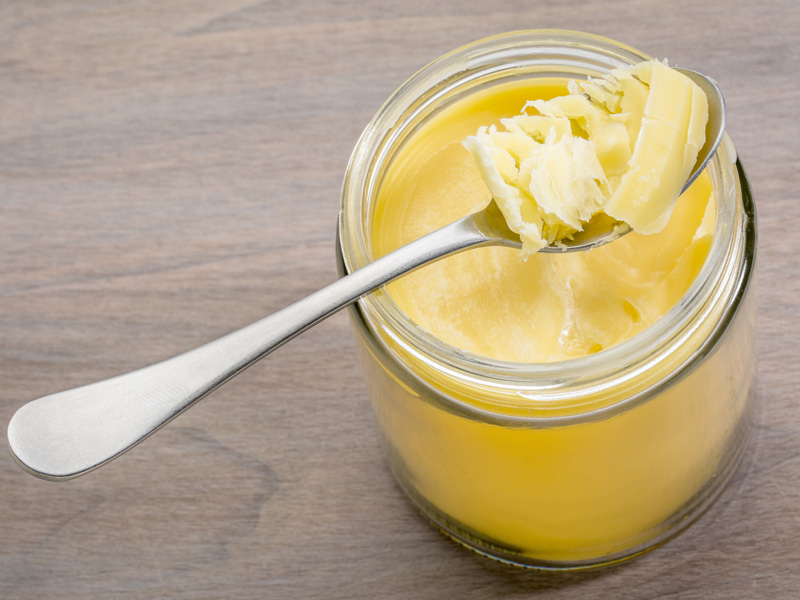
- Excess consumption of ghee is not recommended as ghee is high in saturated fatty acids and can increase the risk of developing cardiovascular diseases or high cholesterol.
- Ghee that is prepared from cow or buffalo milk is the only one that could yield benefits. Ghee prepared from vegetable oils does not have the benefits of naturally prepared ghee.
- Ghee has a higher smoke point of around 480 degrees which prevents it from turning rancid.
- Individuals with lactose intolerance might not have allergic symptoms with the consumption of ghee as the process of clarification removes lactose. Individuals suffering from lactose intolerance can also consult a doctor or dietician regarding whether to consume ghee.
- Ghee does not require refrigeration and can be stored at room temperature.
- Heating vegetable oils produces acrylamide, a toxic component. Heating ghee, on the other hand, produces lesser amounts of acrylamide compared to vegetable oils.

